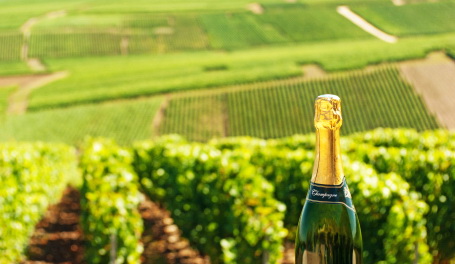 The sparkling wine Champagne is named after the northern region of France where it’s produced.
The sparkling wine Champagne is named after the northern region of France where it’s produced.
Other regions of France, as well as other countries, make sparkling wine, but only those from Champagne may be called Champagne. You’ll find my most recent Champagne reviews and ratings here.
5 Surprising Facts about Champagne:
 1. Supposedly the eighteenth-century blind Benedictine monk, Dom Pérignon, accidentally discovered how to put the bubbles in Champagne when his wines started fermenting again in the spring after the cold winter had stopped them.
1. Supposedly the eighteenth-century blind Benedictine monk, Dom Pérignon, accidentally discovered how to put the bubbles in Champagne when his wines started fermenting again in the spring after the cold winter had stopped them.
Other records attribute this discovery to the British scientist Christopher Merret thirty years before Pérignon.
2. Pérignon is credited widely with improving the techniques of blending wines from different years as well as the three principle grapes used: the white grape Chardonnay and two red grapes, Pinot Noir and Pinot Meunier.
3. The process today still involves a first fermentation to make the still, acidic wine. Then, before bottling, a small amount of wine, sugar and yeast is added (“liqueur de triage”) to trigger a second fermentation in the bottle, where the carbon dioxide bubbles are trapped.
4. The bottle is gradually tilted upside down (riddling), by hand or machine, and eventually the dead yeast cells gather in the neck and are disgorged so that the wine is clear.
5. Before the final cork seal is affixed, the wine is topped up with a small amount of wine and sugar (liqueur d’expédition). The amount of sugar determines whether the bubbly will be Brut (very dry), Sec (off-dry) or Demi-Sec (medium-sweet).
Rosé bubbly is made either by blending red and white wine or by limiting the skin contact of the red grapes during maceration, when the grapes soak in their own juice before fermentation.
Blanc de blancs Champagne is made only from Chardonnay while blanc de noirs is only from Pinot Noir and Pinot Meunier.
The grapes for vintage Champagne that show a year on the label were harvested from one year only, while non-vintage Champagne are grapes and wines blended from many years.
While Vintage Champagnes age well, non-vintage bubblies are meant to be consumed within a year or two of purchase while they still have their fruit freshness.
Many producers outside of the Champagne region use this process and grapes to make their bubbly and often put méthode traditionnelle on their label.
The words Champagne and méthode champenoise may not legally be used by producers except those from Champagne itself.
When you join our wine community as a Paid Member, you’ll get access to all of my Sparkling wine reviews, which are updated weekly.







